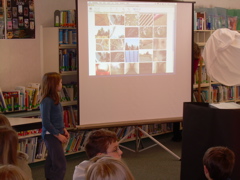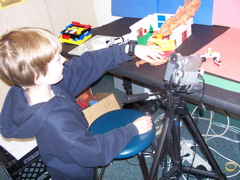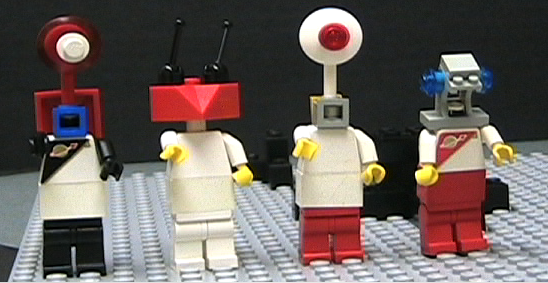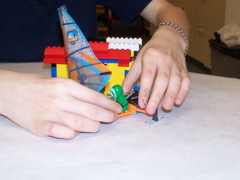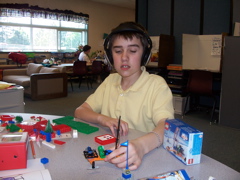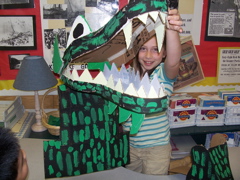|
|
May 3, 2007
I
returned from two very long and difficult days of collective bargaining
with the school district for next year's school employees' contract to
find that the fifth graders involved in "Mission to Earth" had
rehearsed a few of the scenes and had recorded them in GarageBand in my
absence! I was particularly pleased because I had left a note for Paul,
who was ill on Monday when I was last at school, explaining that I was
away and that it would be nice if they could get scene 4 recorded. They
ended up recording three scenes!
Today the students worked
on the scene where the astronaut and his Martian friend visit Pluto. I
was involved with three different projects simultaneously, so I spoke
with the director about the three different camera angles that I
envisioned for the scene. Additionally, ahead of time I listened to and
timed the dialogue, so we knew that we needed about ten seconds of
footage to complete the scene. The film is very fast-paced, like a
music video. I left the students to film while I checked in with Henry
and the soundtrack and got a couple of girls started with storyboarding
a stop-motion film of their own. These two girls had been involved with
the stop-motion film (one as a sound engineer, the other as an actor)
and helped to paint the dragon for Beth's film. It is encouraging to
see them striking out on their own to produce another film. By the end
of the day they had their film storyboarded, so we will meet tomorrow
to discuss the logistics of filming the movie and the script.

As
Paul and his cameraman worked on recording the scene, others reviewed
the footage that I edited and with their dialogue and Henry's
soundtrack added. The movie is shaping up to be excellent, their best
yet. Paul added an additional scene to the three that I suggested, a
scene that helped clarify the action.

I went to Nick's classroom right before recess to ask him if he might be able to come by and finish the Plutonians he designed.
He came to the lab where the students are filming before anyone else. I
provided him with a small container of my "choice pieces" to finish his
Plutonian. He found a very unique Lego for the head and added a few
more features. It did not take him too long, so I found another Minifig
body and asked him if he could make another. He asked if it were
alright if this Plutonian could look similar to another he had already
made, to which I replied, "Of course."

After
he finished his Plutonians, he asked me whether they had any dialogue
in the movie. Two students already recorded some zombie-noises for when
the Plutonians appear. I suggested that Nick might be able to come up
with some dialogue on his own and we could record it in GarageBand and
filter his voice so it sounded like an alien's. He came up with the
first line, "Sky beings! Get them!" He and I worked on the remaining
three lines. Paul, the director, heard the Helium effect when he and
the others recorded their dialogue and suggested it might be a good
effect for the Plutonians' voices. Nick agreed, stating that if there
were an atmosphere on Pluto it would be very thin, which might give
inhabitants high-pitched voices. He and I arranged to meet at lunch
recess to record his dialogue. First we recorded my voice, testing the
Helium effect. He thought it sounded very funny. He decided that since
the effect was going to make his voice sound higher in pitch, he would
speak in a high-pitched voice so it would sound even stranger when
filtered. We recorded his lines. I asked him if this were real and the
Plutonians were serious about catching the astronaut and the Martian,
would they take turns talking? He suggested that we layer the voices
over one another. We cut the clip into different clips and moved them
to different tracks so we could slightly overlap them. He suggested we
move one of the lines ahead in sequence. Then he thought about the
Helium effect and decided there must be a better effect. We tried a
couple and I suggested the Celestia effect, because his voice was clear
but definitely filtered. He liked it and we presented it to the
director, who also liked it.
This morning I managed to
turn a plastic water bottle into a waspworm, another character in
Beth's movie. I covered it in construction paper and used scotch tape
to hold it all together. The stinger comes out as the main character
has to retrieve one for part of a potion. I taped a cut and bent coat
hanger to it and brought it out to show Beth.

She
approved of the design but wanted the head slightly larger, which I
modified. I suggested I could assemble the paper pieces needed to put
together waspworms and students could assemble a couple more for the
"swarm" in the film, which she thought was a good idea. She also wanted
the coat hanger to be mounted to the top of the waspworm I explained
that if it were mounted on the underside that the waspworm could be
moved around and filmed without the person holding the hanger in the
frame, so it would really look like it was flying. I do not think that
Beth realizes yet how we are going to capitalize on many closely-framed
shots to make the creations look much more realistic and large. I
photocopied for her early in her process of starting her film a page
from Making Real Life Videos that has visual examples of
different types of framing used in movies. I am going to refer to this
sheet with her again, along with a copy of this photograph as well as a
close-up of the dragon's arm to show her how it can be made to look
large and realistic. Perhaps she can experiment with a video camera and
close-up shots to see how she can make her scenes look more realistic
with proper framing.
In my absence there was turmoil in
the audition process. I went out to Beth's classroom this morning to
return the paint that we used and was immediately asked by several
girls whether I could come to recess to help "judge." I was not certain
what they were asking me to judge but I assumed they meant the
auditions. Laura confided to me, whispering that Beth had not been
"fair" in her casting, she felt. Some girls were upset that they had
not been given "great" ratings without receiving feedback from Beth as
to how they might improve. Did Beth not share her rubric that she used
for auditions and did the other students not clearly understand what skills Beth assessed ?
Beth said that there were not going to be any more auditions that day
when a few girls in the class started to get involved in the
conversation. Clearly she felt that she had lost control of the
situation and was going to take back control. I asked her if she needed
any help with the audition process and she said she did not.
By
the middle of the day she was auditioning students for the remaining
roles. She lost one actor to another film that a group of third grade
girls have also started independent of Tech Club, interestingly. I
provided the director, a third grade girl who is also starring in
Beth's film, with storyboard sheets and an offer for her to use one of
the school's video camera. She took a movie making class elsewhere and
has a good sense how to accomplish her goals, but she was not certain
what software she learned to edit her film with. It is interesting that
Beth's film has influenced these girls to start a film as well. I
wonder whether these girls will approach me to help with their film or
will they remain independent of Tech Club? Regardless, these girls are
using technology in a self-directed and self-initiated project that
involves other students, some of whom feel that they were slighted in
an opportunity to participate in the limited roles that are available
in Beth's film. The role of relationships and technology use, explored
in my literature review,
must be noted in this real-world example. They have posted many signs
around school advertising the casting of their film, open to both boys
and girls. Beth's film has only one male role, which she might cast
with a girl. It will be interesting to see if boys choose to
participate in this other film, "Zanzibar."
I am very
excited by Paul's leadership and the ability of the cast, unsupervised
by me, to accomplish so much work. Paul's animation and directing shows
refinement from the three years he worked on stop-motion films both in
Tech Club and independently at home with his siblings. Beth's
management of the auditioning process breakdown shows she is committed
to her project and to getting the "best," as she describes it, for each
role. Her influence on her peers caused others to start similar
projects independent of Tech Club, an interesting and new development.
All of this occurred mainly in my absence, which is quite amazing and
which shows the independence and empowerment that this project has
given these students.
|
